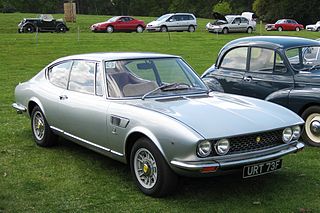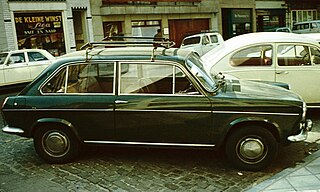
Autobianchi was an Italian automobile manufacturer, created jointly by Bianchi, Pirelli and Fiat in 1955. Autobianchi produced only a handful of models during its lifetime, which were almost exclusively small cars, with the biggest being the short-lived Autobianchi A111, a small family car. Autobianchis were priced higher than Fiat models of similar size and the brand was used by Fiat to test innovative concepts which later found their way into mainstream Fiat vehicles; these concepts included fibreglass bodies and front-wheel drive.

The Fiat 128 is a transverse front-engine, front wheel drive small family car manufactured and marketed by Fiat from 1969 to 1985 as a two- or four-door sedan, three- or five-door station wagon as well as two- or three-door coupé. The 128 running gear and engine, reconfigured for a mid-engined layout, were used in the Fiat X1/9 sports car.

The Fiat X1/9 is a two-seater mid-engined sports car designed by Bertone and manufactured by Fiat from 1972–1982 and subsequently by Gruppo Bertone from 1982–1989.

The Fiat 127 is a supermini car produced by Italian car manufacturer FIAT from 1971 to 1983. It was introduced in 1971 as the replacement for the Fiat 850. Production of the 127 in Italy ended in 1983 following the introduction of its replacement, the Fiat Uno, although the nameplate continued to be used on cars imported from Brazil.

The Fiat 124 is a small family car manufactured and marketed by Italian company Fiat between 1966 and 1974. The saloon superseded the Fiat 1300 and was the basis for several variants including a station wagon, a four-seater coupé, a two-seater convertible and a lengthened and more luxurious version, the 125, launched in early 1967.

The Fiat 500 is a rear-engined, four-seat, small city car that was manufactured and marketed by Fiat Automobiles from 1957 until 1975 over a single generation in two-door saloon and two-door station wagon bodystyles.

The Fiat Dino was a front-engine, rear-wheel-drive sports car produced by Fiat from 1966 to 1973. The Dino name refers to the Ferrari Dino V6 engine, produced by Fiat and installed in the cars to achieve the production numbers sufficient for Ferrari to homologate the engine for Formula 2 racing.

Front-wheel drive (FWD) is a form of engine and transmission layout used in motor vehicles, where the engine drives the front wheels only. Most modern front-wheel drive vehicles feature a transverse engine, rather than the conventional longitudinal engine arrangement generally found in rear-wheel drive and four-wheel drive vehicles.

In automotive design, a front-engine, front-wheel-drive (FWD) layout, or FF layout, places both the internal combustion engine and driven roadwheels at the front of the vehicle.

The Alfa Romeo 33 is a small family car produced by the Italian automaker Alfa Romeo between 1983 and 1995. From a mechanical standpoint it was essentially an evolution of its predecessor, the Alfasud, whose floorpan, chassis and drivetrain were carried over—albeit with modifications to the suspension and braking system. The Nissan-based Alfa Romeo Arna was launched shortly after, offering a similarly sized but lower priced car.

The Lancia Fulvia is an automobile produced by Lancia between 1963 and 1976. Named after Via Fulvia, the Roman road leading from Tortona to Turin, it was introduced at the Geneva Motor Show in 1963 and manufactured in three variants: Berlina 4-door saloon, 2-door Coupé, and Sport, an alternative fastback coupé designed and built by Zagato on the Coupé floorpan.

The Lancia Beta was an entry-level luxury car produced by Italian car manufacturer Lancia from 1972 to 1984. It was the first new model introduced by Lancia after it had been taken over by Fiat in 1969.

The Autobianchi Primula is a supermini economy car manufactured between 1964 and 1970 by the Italian automaker Autobianchi, partly owned by and later a subsidiary of the Fiat Group. The Primula was a prototype for Fiat's rack and pinion steering and is widely known for its innovative Dante Giacosa-designed front-wheel drive, transverse engine layout — that would be later popularized by the Fiat 128 to ultimately become an industry-standard front drive layout.

A transverse engine is an engine mounted in a vehicle so that the engine's crankshaft axis is perpendicular to the direction of travel. Many modern front-wheel drive vehicles use this engine mounting configuration. Most rear-wheel drive vehicles use a longitudinal engine configuration, where the engine's crankshaft axis is parallel with the direction of travel, except for some rear-mid engine vehicles, which use a transverse engine and transaxle mounted in the rear instead of the front. Despite typically being used in light vehicles, it is not restricted to such designs and has also been used on armoured fighting vehicles to save interior space.

The Lancia Prisma was a small family car built by Italian car manufacturer Lancia between 1982 and 1989. It was a saloon version of the first generation Lancia Delta hatchback, and like the Delta it was designed by Giorgetto Giugiaro. Like the Delta it was also available as a 4x4 integrale version, although with a non-turbocharged engine and an air-locking rear differential.

The Fiat 850 is a small rear-engine, rear-wheel-drive car manufactured and marketed by Italian car manufacturer Fiat from 1964 to 1973.

Dante Giacosa was an Italian automobile designer and engineer responsible for a range of Italian automobile designs — and for refining the front-wheel drive layout to an industry-standard configuration.

The Fiat 1300 and Fiat 1500 are a series of front-engine, rear-drive automobiles manufactured and marketed by Fiat from 1961 to 1967, replacing the Fiat 1400 and Fiat 1200 coupé, spyder and cabriolet. The 1300 and 1500 were essentially identical to each other except for their engine displacement, as indicated by their model names, and were offered in sedan/saloon, station wagon, convertible and coupé body styles which shared little mechanically with the other body styles except the 1500 engine.

The Fiat Trepiùno is a transverse front-engine, front-wheel drive, four-passenger concept city car introduced by Fiat at the 2004 Geneva Salon international de l'auto; styled at the Centro Stile Fiat; powered by a 54 hp 1100cc engine and built by the Turin-based company, I.DE.A.

The Autobianchi A112 Runabout is a concept car developed by Bertone and first shown in 1969. The small two-seat, mid-engined car was the inspiration for the Fiat X1/9 that appeared in 1972.




















